
Pinus ponderosa, commonly known as the ponderosa pine, bull pine, blackjack pine, western yellow-pine, or filipinus pine is a very large pine tree species of variable habitat native to mountainous regions of western North America. It is the most widely distributed pine species in North America.

Grindelia (gumweed) is a genus of plants native to the Americas belonging to the family Asteraceae. The genus was named for Latvian botanist David Hieronymus Grindel, 1776–1836.

Chrysothamnus, known as rabbitbrush, rabbitbush, and chamisa, are a genus of shrubs in the family Asteraceae. The native distribution is in the arid western United States, Canada, and northern Mexico. It is known for its bright white or yellow flowers in late summer.
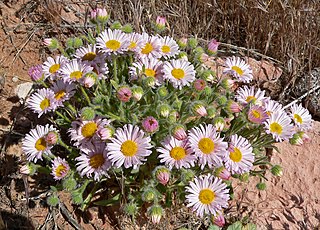
Erigeron concinnus, the Navajo fleabane, tidy fleabane or hairy daisy, is a perennial flowering plant in the family Asteraceae.

Langloisia is a genus of flowering plants in the in the family Polemoniaceae. It is monotypic, being represented by the single species Langloisia setosissima, also known as bristly langloisia, bristly-calico, Great Basin langloisia, and lilac sunbonnets. It is native to the western United States and north-western Mexico, where it is found in desert washes and on rocky slopes and plains from eastern Oregon and Idaho, south via Nevada and Utah to eastern California and Arizona.

Hymenoxys is a genus of plants in the sunflower family, native to North and South America. It was named by Alexandre Henri Gabriel de Cassini in 1828.

Ericameria nauseosa, commonly known as chamisa, rubber rabbitbrush, and gray rabbitbrush, is a shrub in the sunflower family (Aster) found in the arid regions of western North America.
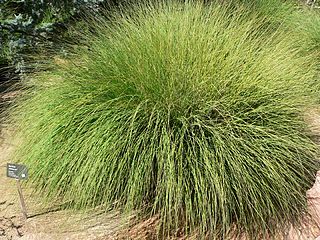
Muhlenbergia is a genus of plants in the grass family.
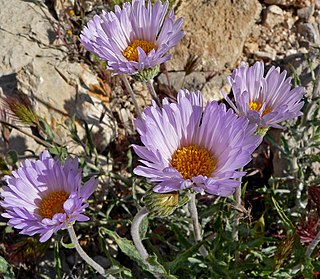
Xylorhiza is a genus of flowering plants in the family Asteraceae, known as woodyasters. These are daisylike wildflowers usually having blue to purple or white ray flowers with yellow centers of disc florets. Woodyasters are native to western North America.

Balsamorhiza is a genus of plants in the family Asteraceae known commonly as balsamroots. These are perennials with fleshy taproots and caudices bearing erect stems and large, basal leaves. Atop the tall stems are showy yellow sunflower-like blooms. Balsamroots are native to western North America.

Crepis occidentalis is a North American species of flowering plant in the family Asteraceae known by the common names western hawksbeard, or largeflower hawksbeard. It is native to western Canada and the western United States.

Crepis runcinata is a North American species of flowering plant in the family Asteraceae known by the common name fiddleleaf hawksbeard. It is native to western and central Canada, the western and central United States and northern Mexico (Chihuahua).
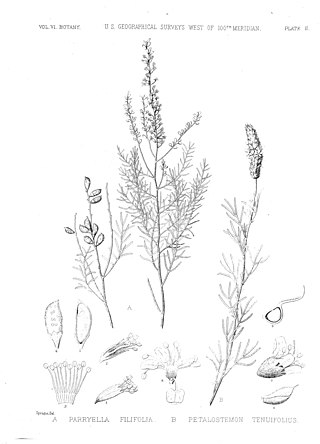
Parryella filifolia, the common dunebroom, is a species of flowering plants in the family Fabaceae. It belongs to the subfamily Faboideae. It is the only member of the genus Parryella. It is native to Arizona, Colorado and New Mexico.
Herrickia is a former North American genus of flowering plants in the family Asteraceae, native to the western United States. In 2004 it was proposed to revive the genus with species that were included in Aster before molecular studies triggered the splitting of that genus into several distinct genera. However, the status of this genus is disputed with Plants of the World Online (POWO) synonymizing it with Eurybia as of 2023.
Lorandersonia, commonly called rabbitbush, is a genus of North American flowering plants in the family Asteraceae.
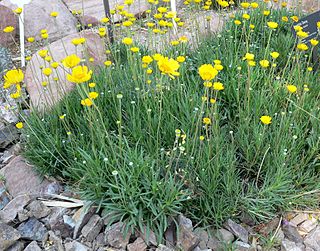
Tetraneuris, commonly known as four-nerve daisy or bitterweed, is a genus of North American plants in the sneezeweed tribe within the daisy family.
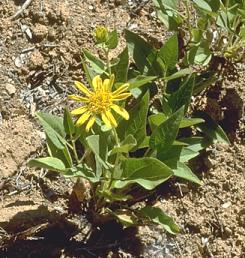
Agnorhiza is a small genus of flowering plants in the family Asteraceae described as a genus in 1998. Its species had previously been considered members of either Wyethia or Balsamorhiza. The plants are native to California, with the range of one species (A. ovata) extending into northern Mexico. They are perennial herbs with sunflower-like flower heads 1 to 4 centimeters wide.

Brickellia microphylla, the littleleaf brickellbush, is a flowering plant species in the family Asteraceae native to western North America.

Eurybia glauca is a North American species of flowering plants in the family Asteraceae, called the gray aster. It is native to the western United States, primarily in Arizona, New Mexico, Utah, Colorado, and Wyoming, with a few populations in Idaho and Montana.
Delwiensia is a monotypic genus of flowering plants belonging to the family Asteraceae. The only species is Delwiensia pattersonii, also known as Patterson sagewort or Patterson's wormwood, and formerly Artemisia pattersonii. The species is found in Western Central USA, growing in the Rocky Mountains of Wyoming, Colorado, and New Mexico.


















